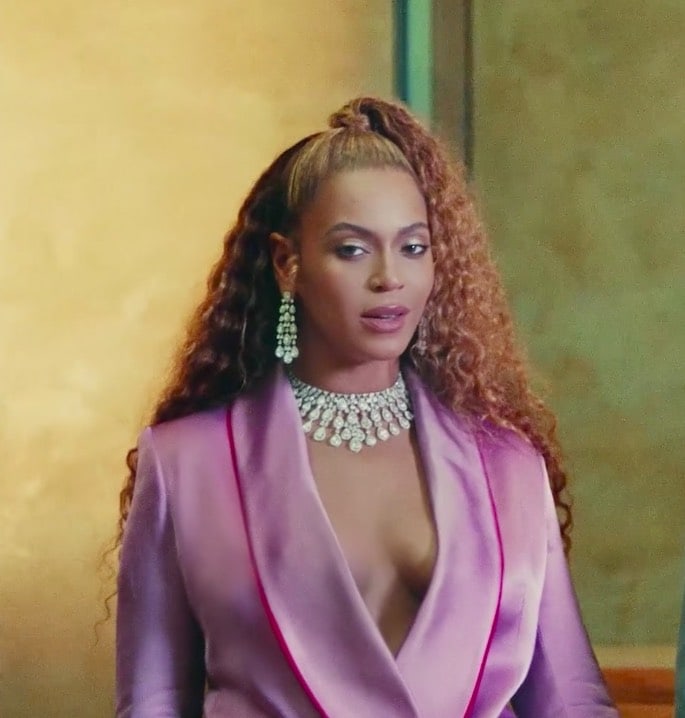 Parkwood Entertainment/ Roc Nation
Parkwood Entertainment/ Roc Nation
Theodore Barrow is best known as the eloquent and unflinchingly critical ruler of satirical skateboard clip review Instagram account @feedback_ts. His loquacious yet stunningly succinct asides on art history that find their way into his reviews are mostly lost on a large percentage of his sizable following, who seem content to pick (and lose) asinine fights with him about skateboarding. Nevertheless, he shows an impressive — albeit occasionally bewildering — commitment to sharing his insight with the kickflipping masses.
Barrow is an art history PhD candidate at CUNY's Graduate Center, while working as a museum curator at the Hudson River Museum in New York, and as an art history professor at Barnard College. On @feedback_ts and in real life, Barrow excels at making connections from the cultural happenings of centuries past to those today. When Beyoncé and JAY-Z dropped their video for "APESHIT," the most glamorous trip to the Louvre ever recorded, we thought it wise to call on Mr. Barrow's expertise.
First of all, what were your initial reactions to the “APESHIT” video?
My first reaction, was being thrilled that art was being featured in a music video at all. The video itself is gorgeously shot, and does show a continued interest in art on behalf of the artists, JAY-Z and Beyoncé, to engage with art (notable precursors being JAY-Z's "Picasso Baby," and Beyoncé's use of David Hammons and Richard Prince in “7/11”). The relationship between Julie Dash and Arthur Jafa's Daughters of the Dust and Beyoncé's Lemonade was, to my mind, a brilliant way to incorporate art in a music video, elevating the music and, in some ways, highlighting the artistic inspiration. I'm less sure about this current project. My second thought, and I'm not proud of this, was, ruefully "cool, more museum selfies." One of my pet peeves is, in spite of how many visitors there are in museums, how little time people actually spend looking at the art. People photograph everything, look but don't see, understanding very little of context. Art is not merely a photo-op, and posing in front of art is reducing it to a backdrop. This can be a problem.
Now, obviously JAY-Z and Beyoncé looking at art at the museum would be a really boring music video (though I would love to be a fly on the wall to overhear their conversation about the Mona Lisa). It's not the responsibility of the artists featured nor the director to give each painting its proper due, but I did feel like the art was only being used as a backdrop in this case. Art was being used to signify status with no meaning outside of cultural capital and luxury. Another uneasy response was immediately thinking of those memes of Puff Daddy standing in front of the Mona Lisa, etc. The enshrinement of an image, especially something as ubiquitous as the Mona Lisa, can be dangerous, as it strips the work of art of its multivalent interpretations and only uses it as a sign that essentially reads: status.
 Parkwood Entertainment/ Roc Nation
Parkwood Entertainment/ Roc Nation
Analyzing the artists' intentions, what do you think motivated Beyoncé and JAY-Z to make this video at the Louvre, beyond simply flexing the fact that they are rich and culturally powerful enough to do so?
I know that JAY-Z is an art collector, and his in-ness with art world types has been well-documented (see “Picasso Baby”). I also know the difference between the persona of the rapper JAY-Z and Shawn Carter the entrepreneur and, perhaps, aesthete. I do think, however, that the public persona of the rapper and hustler unfortunately strips the acquisition and appreciation of art to commodity. It reminds me of the story he recounted in Decoded when a reporter who had been interviewing him got distracted by the paradoxical pairing of his Jesus piece above a Che Guevara t-shirt, and that Carter was so taken aback by that. For Carter, the jesus piece had belonged to Biggie Smalls, thus was something more than a piece of gaudy jewelry, and perhaps the Che shirt symbolized revolution, though of a very different sort than the rudimentary capitalism of the drug dealer, rapper, or entrepreneur. Art can be mean different things to different people, it is never about one thing, but it was difficult for me to see the art which functioned as a backdrop in this video as doing little more than "flexing," as you put it.
Do you get a sense that The Carters's utilization of historical artwork comes from a place of appreciation? Subversion? Both? Something else entirely? What are they trying to say?
Appreciation can mean a lot of things. I don't see how the Mona Lisa, for example, could mean anything more than a cultural destination and exclusivity in the context of this video. I also don't imagine that the Carters solely chose the artworks in the background of each shot: I would guess that this was a collaboration between the director, the production designers, wardrobe, the Louvre itself, and the artists featured. That said, I do not see anything subversive about their "greatest-hits" tour through the Louvre in this video: these are easily-recognizeable works that are reduced to cliche in this video.
To me the most significant theme seems to be the incorporation of blackness into a space that historically has sparsely included black people, or else failed to honor black experience altogether. The Carters transcend the barrier for entry themselves, obviously, but here alongside them they've also brought a troupe of black women dancers — ornately draped and interlocked and laid across the space in a very literal physical way. There's also the multiple vignettes of young black men and women performing similar gestures as the images of art with which they're juxtaposed, which suggests an empowering re-contextualization.
Yes, the incorporation of blackness is in fact very important in spaces that not only have excluded the black subject, but often is filled with objects that have a direct relationship to the historical subjugation of black bodies through slavery and wage exploitation. It is very rare to find examples from art in the Louvre (St. Maurice would be one) of black figures that aren’t used decoratively. This is inexcusable, but it does reflect the narrow worldview and aesthetic mindset of the cultures that created these works of art. It is certainly important to reassert blackness in the universal survey museum. Fred Wilson's "Mining the Museum" interventions are important historical precursors to this project. More recently, Kehinde Wiley's highlighting of black models in old master paintings has done a lot, though not unproblematically, to reassert blackness within the history of old master paintings. Again, in both cases, we are talking about the project of artists who work primarily with ideas, and the music video is a different type of medium altogether. It is not the job of this music video, nor the burden of JAY-Z or Beyoncé, to reverse this exclusion.
I did find the sequences of dancers set against, say, the Nike of Samothrace or the Venus de Milo to be an interesting juxtaposition, and these sequences were the least irksome for me. However, a history of art that treats the black body as decorative is not adequately rectified by a video that treats this art history as decorative. In fact, given the budget of a video of this scale, the exorbitant costs of renting a public museum for the purposes of shooting a video at the Louvre, and all of the labor involved in the production of this video, I suspect that the product only pays lip service to correcting a history of exclusion. It is more likely that videos like this featuring billionaire artists bolsters the dominant culture rather than challenging its power.
 Parkwood Entertainment / Roc Nation
Parkwood Entertainment / Roc Nation
The two paintings most prominently featured (aside from the Mona Lisa, we'll get to her in a minute,) are The Coronation of Napoleon and The Raft of the Medusa, each respectively employed as backdrops for Beyoncé and JAY-Z in the scenes where they aren't together. In these shots, the performer is small in the frame while the painting looms behind them. What should we know about each of these paintings? What's being said thematically by choosing these particular works?
This is a great question: the Coronation of Napoleon, by Jacques-Louis David, is significant in this context because Napoleon created a meritocracy where hard work, rather than birthright or aristocracy, equalled success. At least, that was the idea. France had abolished the monarchy bloodily in the 1790s, and Napoleon declared himself Emperor, crowning himself rather than waiting on the pope to do so. At best, within the context of this video, it's about the ascendancy of a smart, talented individual who redefines power and creates an empire. At worst, it's only seen as a symbol of power itself, and the tragic and irreversible end of Napoleon's reign, just over a decade of his coronation, offers no historical lessons. Speaking specifically of the history, Napoleon wanted to reinstate slavery in French colonies.
The Raft of the Medusa, 1818-19, by Gericault, is also an interesting choice. After the fall of Napoleon, Bourbon rule was re-established. Louis XVIII handed out cushy jobs to his aristocratic cronies, which led to the debacle of the Medusa. The story goes, the Medusa was trading with West Africa, and the intent was to resume slave trading. Slavery had been abolished during the French Revolution, but Napoleon's plans to use slavery in Africa was also considered under the Bourbon kings after 1815. The captain of the Medusa was incompetent, the ship ran into a sandbar, and 150 sailors from the lower decks were forced onto a raft that would lessen the load of the ship and allow the vessels to return to Europe. Or so they thought. A raft was quickly constructed, 150 men boarded it, and it was tethered to the Medusa by a rope. Unfortunately, the Medusa was still weighted down, so the ship's crew made a quick decision and cut the rope, abandoning the 150 sailors to a raft that had no food, only casks of rum. When the rum ran out, the drunken sailors became delirious. Many got sick. Many died. Murder, suicide, drowning, and cannibalism out of desperate starvation was practiced. Within two weeks, only 13 men survived out of the original 150. This debacle was seen as a scathing indictment of the incompetence of authority under Louis XVIII. Gericault's painting shows a moment of delusion, where a pile of bodies, crowned by a black sailor, writhes towards a flag in the false hope that the ship on the horizon will rescue them. This was not the moment that they were rescued. Given the context of this painting and its controversial history, it is difficult to see how this painting about slavery and careless brutality could have served as an appropriate backdrop in this video, but, I guess, it's a popular, well-known image.
These are a handful of paintings that we see in closeup for like, one second each. What can you tell us about any of them?
 Parkwood Entertainment / Roc Nation
Parkwood Entertainment / Roc Nation
This is a detail of one of the Sabine women from Jacques-Louis David's "Intervention of the Sabines," from 1799. The painting depicts the moment when the Sabine men, who had mounted a counterattack against the Romans (who had stolen their women a few years before in order to start the roman civilization), are interrupted by the Sabine women, now wives of the Roman soldiers and mothers of Roman babies. It's a painting that is about putting down your weapons after all of the violence of the revolution, of which David was intimately involved. It would be nice to think that this painting has special significance to the Carters, as Beyoncé's brilliant Lemonade album was about infidelity, devotion, and reconciliation, which are also touchstone themes for David's painting here.
 Parkwood Entertainment / Roc Nation
Parkwood Entertainment / Roc Nation
This is a wedding banquet scene by Veronese, depicting the Wedding Feast at Cana, where Jesus converts water into Wine. Veronese was a venetian painter who transformed the biblical scene into a contemporary (16th century) banquet. It's mannerist, overly-styled, and opulent, and the liquid miracle, itself about purity (water) and christ's eventual bloody martyrdom (wine), is somewhat overshadowed by the orgiastic feast in the foreground. I guess the themes of opulence and spirituality could connect between the painting and the video, and it syncs nicely with Beyoncé's verse about sipping on her favorite alcohol.
 Parkwood Entertainment / Roc Nation
Parkwood Entertainment / Roc Nation
This is by Marie Benoist (one of David's students), titled "Portrait of a Black Woman, (or Negresse),” of 1800. It is, in fact, a pretty rare depiction of a beautiful black woman in a mode that is closely tied to not only the depiction of the seated virgin mary but also to mythological goddesses. The context for this painting is somewhat unknown, this may have been a woman brought back by the artist's mother, and we do not know Benoist's position within the heated debates around slavery in this period, but, as with all of this art, it can speak many different voices and say many different things to the audience. I suspect that it is used in this video as an example of triumphant enshrinement of the black subject, particularly when juxtaposed with the primarily white figures in nearly all of the other paintings glimpsed in this video.
I'm struck by this one moment where two dancers are posed in front of the Portrait of Madame Recamier, and neither Beyoncé nor JAY-Z are pictured. What do you make of this shot?
 Parkwood Entertainment / Roc Nation
Parkwood Entertainment / Roc Nation
This one is weird, compositionally: it's as if the figures themselves now resemble the chair, their conjoined headscarves subtly echoing the shape of the chair and Mme. Recamier. They, like the furniture in the painting, sit uncomfortably on the floor. Again, this is why the use of art in this video seems paradoxical: when only used as a luxurious backdrop, it reinforces this subtext of subjugation, rather than empowering, in this case, the dancers.
Just so this isn't all about the paintings, let’s mention the handful of sculptures in there. Any strong feelings about the use of the Sphinx, Venus de Milo, and/or the Nike of Samothrace?
In the same way that these sculptures have been decontextualized from their host countries (Hellenistic Greece, Egypt, Rome, etc) and put into a museum in the 18th century, so too are they even more confusingly placed in this video. The cultural context to which they belonged, the world of symbols and ideas attached to them, seems somewhat bereft in this video.
Finally, what can you tell us about the The Carters's (and the world's) fixation with the Mona Lisa? What makes her such a persistent cornerstone in the history of fine art that even JAY-Z and Beyoncé are transfixed by her?
Yeah, I guess it's nice that the video concludes with them finally turning to actually look at the Mona Lisa. It is the only moment when the art in the Louvre is the focus of the performers. That moment lasts about half a second which is, sadly, the amount of time most visitors to any museum spend looking at a work of art.
Of course, thousands of pages have been written, theories bandied about, about the phenomenon of the Mona Lisa. I'm not an expert in Renaissance art, but this is my take. First, this is a painting that for some reason Leonardo kept with him his entire life. The painting depicts the young bride of a wealthy Florentine who paid Leonardo to paint his bride, but Leonardo, a famous finnicky tinkerer even in his lifetime, never delivered. Eventually he leaves Italy and settles in the Court of Francois I, the king of France. The Mona Lisa thus ends up in the French Court. I believe it hung in Napoleon's bedroom in his palace at the Tuileries. Once the Louvre, which had been a private palace, was turned into a public museum after the French Revolution of 1789, the Mona Lisa was simply one of many Italian paintings on view. It was important, sure, but only as a sign that France had been the rightful inheritor of humanist, renaissance ideals of Italy of the 16th century. Nobody much cared about the Mona Lisa until the early 20th century, when an Italian carpenter who worked at the Louvre attempted to steal the painting and repatriate (send it back to Italy). It went missing, and there was a huge newpsaper sensation and investigation which brought in people like Picasso into the courtroom. It was finally returned, and that's when it became a sensation. Her enigmatic smile was not too dissimilar from many paintings done by Leonardo and his followers and contemporaries, but because of this sensational history, the Mona Lisa became a thing. It's an interesting story, but one that has more to do with celebrity than artistic merit. So, in this video, it follows that the reigning king and queen of pop culture would turn to this meaningless idol. As any visitor to the Louvre would know now, to see the Mona Lisa is to fight for an inch of visibility among the throngs of smartphone screens facing a 20-foot bulletproof glass box that surrounds the painting. It is hard not to see the Carters enjoyment of this painting, their access to it, as being about exclusivity and the privilege of the fabulously wealthy. Even with all that said, however, I was grateful to see the painting in an almost empty room. I realized that this was one of the first times I had ever seen it this way.
Overall, however, I think this video could just as easily been filmed in Versailles, and I'm curious why that wasn't the location. In the 21st century, although filled with priceless riches, Museums are public institutions. The value of going to a museum is not about the possibility of being able to buy or own any of these works of art, nor about legacy-building. Museums are important because anyone has access to these spaces and has the opportunity to see these works of art in intimate terms. Museums make what has, for centuries, been exclusively private and available to only a select few, public, available to all.
What I found most problematic about this video was 1) how the art was treated as decorative luxury and 2) how it was treated as something that only the very wealthy have access to. This may, in fact, be consistent with the history of art and where art had been seen and by whom before museums, but museums like the Louvre, and the Metropolitan Museum of Art, etc. are fundamentally democratic institutions. They are palaces of learning and aesthetic delectation for everyone, and I object to the way the art was debased through appearing exclusive as an exclusive commodity in this video.


